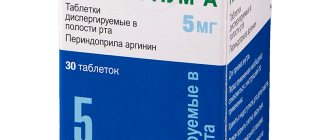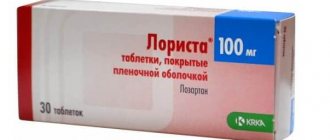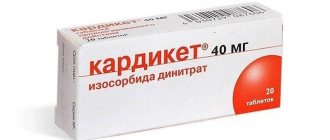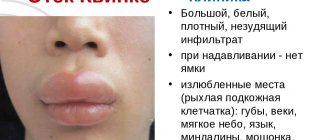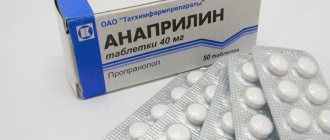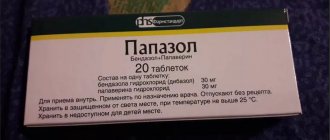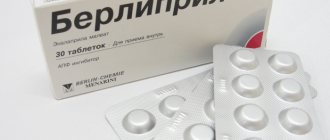Instructions for use of Cordaflex
The drug is aimed at stabilizing blood pressure by blocking calcium channels. Cordaflex tablets produce antianginal and antihypertensive effects on the body, stimulate vasodilation, which reduces the severe symptoms of hypertension. The drug can be purchased only with a prescription and as prescribed by a doctor.
Composition and release form
The drug Cordaflex is available in the form of yellow or red-brown tablets, depending on the quantitative content of the active substance (10 mg, 20 mg or 40 mg). Brown glass bottles have become a common form of packaging. The drug containing 40 mg of the active substance is available in blisters. The number of tablets in bottles is 30/60 pcs., in tablets – 10/30 pcs. The active substance is nifedipine (selective blocker of slow calcium channels based on 1,4-dihydropyridine).
| № | Substances in the composition of the drug | Tablets 10 mg | Tablets 20 mg (extended release, retard) | Tablets 40 mg |
| 1 | Nifedipine | 10 mg | 20 mg | 40 mg |
| 2 | Excipients, mg | Magnesium stearate - 0.3; talc - 1; croscarmellose sodium - 13; lactose monohydrate - 15; MCC - 46. | microcellulose - 99; lactose monohydrate - 30; talc - 2; magnesium stearate - 0.6; hyprolose - 0.5. | cellulose - 10, microcrystalline cellulose - 48.5, lactose - 30, magnesium stearate - 1.5. |
| 3 | Film coating, mg | hypromellose - 2.63; titanium dioxide - 0.82; iron oxide yellow - 0.3; magnesium stearate - 0.25. | hypromellose - 5.26; titanium dioxide - 1.64; iron oxide black/red - 0.12/0.48; magnesium stearate - 0.5. | hypromellose - 2, macrogol 6000 - 0.07, red iron oxide - 0.9, titanium dioxide - 2, talc - 1. |
Pharmacodynamics and pharmacokinetics
Nifedipine, as a selective blocker, reduces the flow of calcium ions into smooth muscle peripheral and coronary arteries, cardiomyocytes. During therapy, it reduces spasmodic phenomena, stress on blood vessels, and myocardial oxygen demand. Blood circulation in ischemic areas of the myocardium improves, and the mass of functioning collaterals increases. Nifedipine does not affect the AV and sinoarterial nodes and does not cause an antiarrhythmic effect. A single dose of Cordaflex RD maintains a positive effect for more than 24 hours and has the following effects:
- reduces vascular tone;
- provides high-quality nutrition to ischemic areas of the heart muscle;
- dilates coronary vessels;
- stabilizes blood circulation;
- reduces myocardial oxygen demand.
Nifedipine is absorbed by 90% from the gastrointestinal tract. In this case, the active concentration of the substance in the myocardium is up to 70%, the rest is distributed throughout the body without a cumulative effect. The maximum effect of the drug is achieved 1 hour after administration and lasts for 6 hours. Nifedipine is excreted in urine (60-80%), the rest is excreted in bile and feces. With impaired renal function, pharmacokinetics do not change.
Indications for use of Cordaflex
The drug is prescribed exclusively by a cardiologist based on the diagnoses. Nifedipine has a pronounced active effect on the myocardium, blood vessels, and arteries, so independent uncontrolled use is prohibited. The drug is prescribed for diseases of the cardiovascular system of varying severity, classified according to the nosological classification of ICD-10:
- arterial hypertension of various origins;
- post-infarction angina;
- stable angina (tension);
- Prinzmetal's angina (angiospastic);
- hypertensive crises;
- vasospastic angina;
- Raynaud's syndrome;
- idiopathic hypertension;
- IHD (coronary heart disease);
- secondary hypertension.
Release form and composition
Cordaflex is available in the following forms:
- Film-coated tablets: yellow, round, biconvex, slightly shiny or matte, with a weak characteristic odor (100 pieces in dark glass bottles, 1 bottle in a cardboard box);
- Extended-release tablets, film-coated: brownish-violet, slightly shiny or matte, round, biconvex, with a slight characteristic odor or odorless, yellow at the break, with a brownish-violet edging (30 or 60 pieces in dark glass jars, 1 can in a cardboard box).
The active ingredient is nifedipine (10 or 20 mg in 1 tablet).
Auxiliary components:
- Film-coated tablets: polyvinyl butyral, talc, lactose monohydrate, hypromellose, magnesium stearate, hydroxypropylcellulose, microcrystalline cellulose, croscarmellose sodium, yellow iron oxide, titanium dioxide;
- Extended-release tablets: lactose monohydrate, croscarmellose sodium, microcrystalline cellulose, magnesium stearate, hyprolose, talc, ethyl acrylate-methyl methacrylate copolymer (2:1).
The composition of the shell of extended-release tablets: titanium dioxide, hypromellose, magnesium stearate, red iron oxide dye.
Directions for use and dosage
The dose of any type of drug is selected individually based on medical history, severity of the disease, and personal tolerance to the active substance. The medicine Cordaflex is taken orally with a small amount of water without chewing before meals. The daily dose should not exceed one tablet for a nifedipine concentration of 40 mg, 2 capsules of 20 mg or 3 capsules of 10 mg per day. If the functioning of the kidneys or liver is impaired, tolerance (addiction) may occur.
Cordaflex 10 mg
Initial dosage: 1 tablet 3 times a day. If necessary (body tolerance, severe form of the disease), the dosage is increased to 40 mg/day. Between doses you should take a break of at least 2 hours. The daily dose should not exceed 40 mg. It is allowed to chew the tablet at the beginning of an attack of angina or hypertensive crisis. For elderly patients, due to changes in metabolism, the daily dose may be reduced. If an increase in dosage to 80-120 mg is required, the patient is transferred to a long-acting drug.
Long-acting tablets
Cordaflex 20 mg is taken 1 capsule 2 times a day. To increase the concentration of nifedipine, the dose is increased to 2 tablets per dose, but the daily dose should not exceed 120 mg. For elderly patients, the beginning of treatment involves a dosage reduced by half. Taking the drug should be divided into 12-hour intervals. The medication is discontinued gradually so as not to cause complications (myocardial ischemia or hypertensive crisis) due to the body becoming accustomed to the constant supply of nifedipine.
special instructions
The drug Cordaflex enhances its effect if the patient is hypovolemic, so the dosage is often reduced. After myocardial infarction, this drug is not prescribed for 30 days. In case of heart failure, before starting treatment, it is recommended to take a course of drugs based on digitalis. Alcohol consumption is strictly prohibited due to the high risk of a sharp decrease in blood pressure. Patients with diabetes should take the drug under constant medical supervision.
At the initial stage of drug therapy, it is recommended to refrain from work requiring a rapid psychophysical reaction. Before surgery, it is imperative to inform the anesthesiologist. If the effect of nifedipine during treatment is insufficient, monotherapy is combined with other drugs.
Indications and contraindications
Before using a medicine, you need to know what it will help with.
Indications for use are:
- increased blood pressure;
- prevention of hypertensive crisis;
- prevention of angina pectoris of any form;
- ischemic heart diseases;
- Raynaud's syndrome (damage to the arteries located in the extremities).
The instructions indicate that the drug is used for hypertension, but does not indicate at what pressure it helps. For effective therapy, indicators should be at the level of 140 (systolic) by 90 (diastolic) mm. rt. Art.
There are a number of pathologies in which you should not take pills:
- severe form of heart failure;
- arterial hypotension (decrease in systolic blood pressure to 90 mm Hg);
- myocardial infarction;
- cardiogenic shock.
If you have a history of the following diseases, the drug should be taken with caution:
- CHF;
- cerebrovascular accidents;
- hypertrophic form of cardiomyopathy;
- arterial hypertension in a malignant course;
- severe tachycardia.
The medicine should also be used with caution in old age. Due to insufficient knowledge of the effect on the children's body, the use of the drug is not recommended for persons under 18 years of age. An absolute contraindication is allergies or hypersensitivity to the components of the medication.
Cordaflex during pregnancy
The drug is prescribed to pregnant women when it is impossible to choose other medications. The use of nifedipine in the first 3 months of pregnancy is strictly not recommended, since the substance can penetrate the placental barrier into the fetal blood. During therapy, the woman and fetus must be constantly monitored by a cardiologist. It is recommended to stop or refuse to use the drug during breastfeeding (nifedipine actively passes into milk during lactation).
Drug interactions
Cordaflex is not used in parallel with alcohol-containing drugs. When combined with Prazosin, Clonidine, Methyldopa, there is a risk of developing orthostatic hypertension. Combining nifedipine with tricyclic antidepressants enhances the antihypertensive effect. Calcium preparations, Rifampicin, Phenytoin, Erythromycin, grapefruit juice, azole antimicrobial agents reduce the metabolism and effectiveness of the active substance Cordaflex.
Side effects
In fact, the drug may cause side effects during the period of use. In most episodes, this is due to a personal reaction to nifedipine or combination with other drugs. More common are facial hyperemia, gynecomastia, hyperglycemia, and visual impairment, which completely disappear after stopping the drug. The remaining side effects will not necessarily occur (the full list is in the instructions for Cordaflex), but there is some risk for the following:
- rare allergic reactions: eczema, urticaria, itching, inflammation of the skin;
- myalgia;
- increased daily diuresis;
- thrombocytopenia, leukopenia, anemia (rare);
- tachycardia;
- swelling of the limbs;
- fainting conditions;
- prolonged constipation, heartburn, diarrhea, nausea, flatulence;
- headache;
- hypoxia;
- hypotension;
- dizziness;
- hyperkalemia;
- sleep disturbance;
- sudden mood changes;
- tremor and convulsions with prolonged high doses of the drug.
Cordaflex analogs
Do not confuse drug analogues and substitutes. In the first, the active substance remains nifedipine, and in the second, they are used when this substance is contraindicated for the patient. All similar medicines differ in dosage, composition and price. It is prohibited to replace Cordavlex on your own, because it is impossible to predict how the body will react to the drug. Main analogues of the drug:
- Nifedipine: an analogue of Cordaflex, which is characterized by low cost and virtually complete consistency in composition;
- Phenigidine: the cheapest among analogues;
- Adalat: an expensive drug with no different effects from the main drug;
- Zanifed, Calcigarl retard, Cordipin, Vero-Nefidipin, Nicardia, Corinfar: complete analogues from different manufacturers.
Composition of the drug
Cordaflex is a medicine for high blood pressure. The composition of the tablet determines the speed and mechanism of action, the likelihood of adverse reactions.
The main component that has a therapeutic effect is nifedipine. It is this substance that stops the flow of calcium ions into the muscle cells of the heart and the smooth muscle cells of the blood supply channels (arteries). Calms the processes of contraction and stimulation of vascular smooth muscles. The number of spasms decreases, the patency of the arteries increases due to expansion.
Under the influence of nifedipine, the myocardial oxygen demand decreases. Blood supply to ischemic areas of the myocardium improves.
Additional substances are:
- cellulose in fine crystals, used as a thickener;
- lactose monohydrate, so-called milk sugar;
- croscarmellose sodium, which gives the tablets easy solubility in water;
- talc is a source of silicon and magnesium;
- other substances that allow the drug to have the expected effect.
The components of the shell are hypromellose (binder), food additive E171 (titanium dioxide), dyes.
Cordaflex price
This drug is in the average price range among its analogues. This is due to its effectiveness and frequency of prescription by specialists. The average cost is available for purchase not only in Moscow or St. Petersburg, but also in the regions. The cost of analogues varies from 22 to 600 rubles, depending on the country of origin and the form of release.
| № | Type of drug, mg | Average price, rub. |
| 1 | Cordaflex 10, 100 pcs. | 85 |
| 2 | Cordaflex 20, 30 pcs. | 90 |
| 3 | Cordaflex 20, 60 pcs. | 125 |
| 4 | Cordaflex 40, 30 pcs | 200 |
Similar means
The most effective products are those containing a similar active ingredient. Cordaflex analogues:
- Corinfar (75-230 rub.);
- Nifecard HL (215-380 rub.);
- Phenigidine (30-60 rub.);
- Calcigard (150-200 rubles).
Only a cardiologist can select the appropriate drug depending on the clinical picture and condition of the patient.

